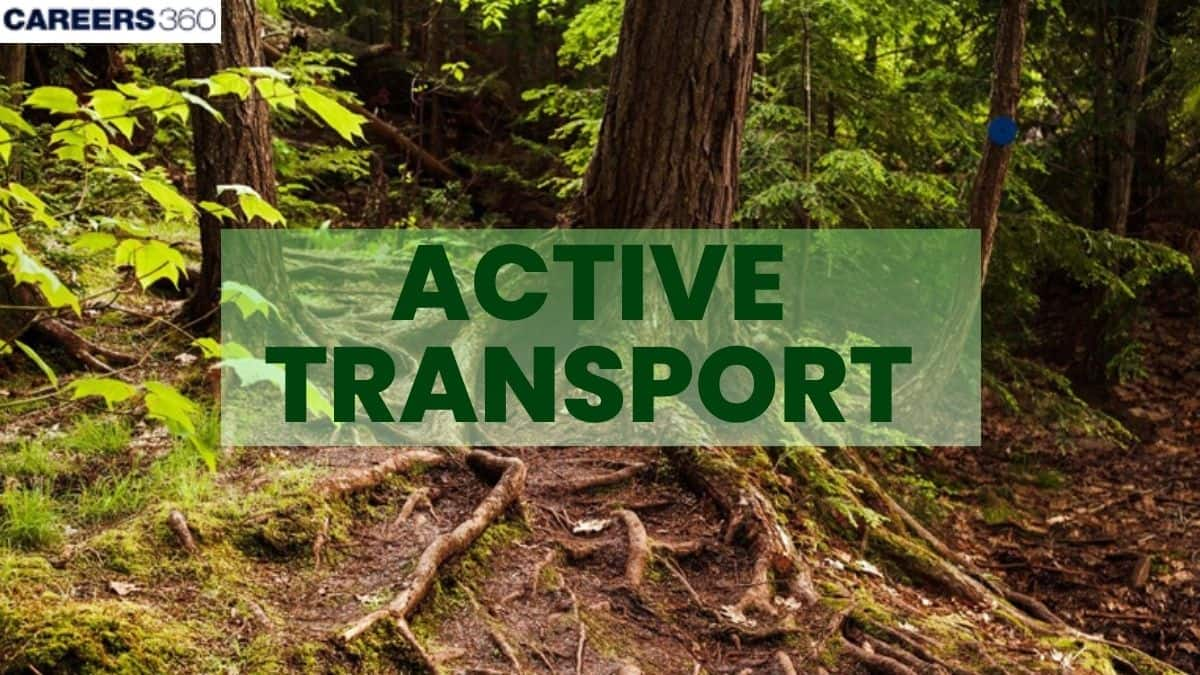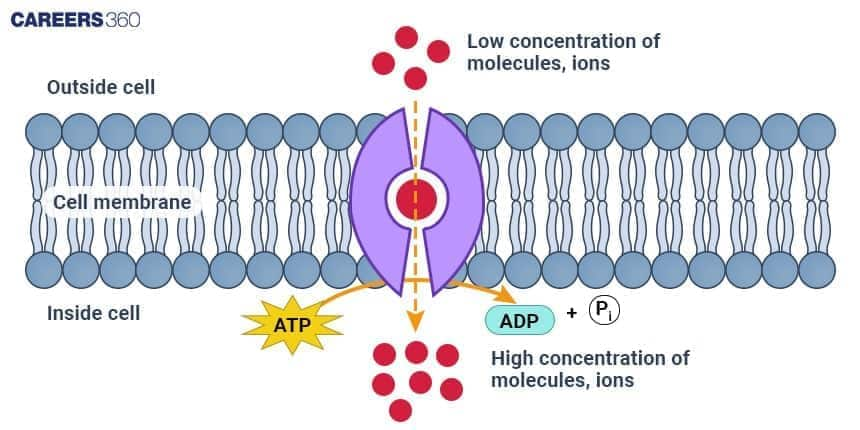Active Transport - Overview, Topics, Definition, Types & Examples
Active transport is the energy-driven process that moves molecules across cell membranes against their concentration gradient. It maintains ion balance, nutrient uptake, and waste removal. Key examples include sodium-potassium and proton pumps.
This Story also Contains
- What is Active Transport?
- Meaning of Active Transport
- Types of Active Transport
- Mechanisms of Active Transport
- Examples and Applications
- Importance of Active Transport
- Active Transport NEET MCQs (With Answers & Explanations)
- Recommended Video on Active Transport

What is Active Transport?
The process by which cells transfer substances from a region of lower concentration to one of higher concentration against the normal flow of diffusion is known as active transport. The nutrients that are present in low amounts outside the cell or the removal of waste products that are present in higher concentrations within the cell depends on this process.
Meaning of Active Transport
The term active transport in botany refers to any molecular movement that needs energy to take place. Active transport uses energy to carry out the required movement of substances across cell membranes, in contrast to passive transport, which depends on the fundamental kinetic energy of molecules.
Types of Active Transport
The different types of active transport mechanisms perform different functions and utilise energy to transport substances across cellular membranes in different ways.
Primary Active Transport
It makes use of ATP directly to pump molecules across their concentration gradient.
Example: Sodium-Potassium Pump, moves sodium ions out and potassium ions into the cell.
It maintains ion gradients and cell volume, thus transmission of the nerve impulse is enabled.
Secondary Active Transport
Transportation of molecules using energy obtained from primary active transport
In symport, the molecules move in the same direction as the driving ion
Example: Glucose and sodium ions transported together into the intestinal cells
In antiport, the movement of molecules is in the opposite direction to that of the driving ion.
Example: Sodium-calcium exchanger pumps sodium ions into a cell while pumping out calcium ions.
Bulk Transport
Endocytosis is the uptake of large particles or liquids by the formation of vesicles.
Phagocytosis is the engulfment of large particles, such as bacteria, from outside the cell as vesicles, a process called cell eating.
Pinocytosis is the intake of fluids and dissolved substances from outside the cell, known as cell drinking.
Exocytosis refers to the release of materials from the cell by the fusion of a vesicle with the plasma membrane.
Example: Neurotransmitters or hormones released by nerve cells and glands.

Mechanisms of Active Transport
The mechanism of active transport in plants is described below:
Primary Active Transport Mechanism
The main components of primary active transport are:
Sodium-Potassium Pump
It pumps out 3 sodium ions from the cell and pulls 2 potassium ions into the cell, both against their concentration gradient.
This is crucial for the maintenance of cellular ion balance, volume, and resting membrane potential.
Proton Pump
The proton pump moves protons across the membrane to build up gradients. It operates in plants, bacteria, and many other organisms, driving many other processes, such as the synthesis of ATP or regulation of pH.
Secondary Active Transport Mechanism
The two main components of secondary active transport are:
Symport
Transporter proteins transport two types of molecules in the same direction across the membrane.
Example: Glucose and sodium ions are transported together into cells in the intestines.
Antiport
Transporter proteins transport two types of molecules in opposite directions.
Example: Sodium ions are exchanged for calcium ions across the plasma membrane.
Bulk Transport Mechanism
Bulk transport is through two main processes:
Endocytosis
The taking in of large amounts of materials by engulfing it into a vesicle.
Includes phagocytosis (cell eating) and pinocytosis (cell drinking).
Exocytosis
A process through which substances are removed from the cell by the formation of vesicles, which fuse with the plasma membrane.
Applied in the secretion of hormones, neurotransmitters, and waste products.
Examples and Applications
The examples and applications of active transport includes:
Active transport is an important aspect in humans under many physiological processes.
It occurs against the concentration gradient of glucose and amino acids in their absorption from food into the intestinal cells.
The establishment of ion gradients through the action of the sodium-potassium pump is very important to the generation of the action potential used in the transmission of nerve signals.
Transport proteins may facilitate the entry of drugs into cells or may impede their entry.
Importance of Active Transport
The active transport process is involved in various physiological activities in plants, particularly in the process of nutrient uptake and maintenance of cellular activities.
Nutrient Uptake
Plants take up most of the essential minerals like potassium, calcium and nitrate from the soil medium into the respective cells against its concentration gradient through active transport.
Specialised cells in the form of root hairs increase the surface area of absorption.
Proton pumps generate a proton gradient across the root cell membrane, which favours ion uptake.
The plant root tends to equilibrate the concentration of hydrogen ions H⁺ in the soil by exchanging them with necessary mineral ions like K⁺, thus promoting uptake.
For instance, potassium ions are absorbed in exchange with hydrogen ions secreted into the soil.
Most plants have symbiotic mycorrhizal fungi that significantly enhance inorganic phosphate and other solutes via active transport mechanisms.
Turgor Pressure
Active transport of ions into the vacuoles of the cell helps to maintain the turgor pressure.
Transport ions like potassium and chloride into the vacuole by using ATP. The water then enters the vacuole in the process of osmosis.
Transport throughout the Plant
Active Transport NEET MCQs (With Answers & Explanations)
The key concepts to be covered under this topic for different exams are:
Types of Active transport
Mechanisms of Active transport
Practice Questions for NEET
Q1. Active transport uses the energy from_________ to transport the molecules from outside to inside across a membrane.
Cyclic AMP
Phloroglucinol
Acetyl chlorine
ATP
Correct answer: 4) ATP
Explanation:
Active transport mechanisms require the use of cellular energy, primarily in the form of adenosine triphosphate (ATP) which is itself formed through secondary active transport using a hydrogen ion gradient in the mitochondria.
Hence the correct answer is option 4) ATP.
Q2. Movement and accumulation of ions across a membrane against their concentration gradient can be explained by
Osmosis
Facilitated diffusion
Passive transport
Active transport
Correct answer: 4) Active transport
Explanation:
Active transport is the process by which ions or molecules are moved across a membrane against their concentration gradient, from an area of lower concentration to an area of higher concentration. This process requires the expenditure of energy in the form of ATP (adenosine triphosphate).
During active transport, specialized transport proteins, such as pumps or carriers, are involved in the movement of ions or molecules across the membrane. These transport proteins actively move the ions or molecules, using ATP as an energy source, to create a concentration gradient that is different from the equilibrium state.
This process is in contrast to passive transport, such as osmosis or facilitated diffusion, where the movement of ions or molecules occurs along the concentration gradient and does not require energy expenditure.
Hence, the correct answer is Option 4) Active Transport.
Q3. In Active absorption, _______cells of the plant play an active role in the absorption of water and metabolic activities.
Stem
Root
Leave
Trunk
Correct answer: 2) Root
Explanation:
In active absorption, the cells of the plant's roots are actively involved in absorbing water and other metabolic activities. The root hair cells, for instance, are involved in the active transport of minerals and water from the soil to the inside of the plant through energy that is required to move the substances against their concentration gradient. The cells also engage in several metabolic activities such as the synthesis of enzymes, which helps in the uptake of nutrients and other cellular functions.
Hence, the correct answer is option 2) Root.
Also Read:
Recommended Video on Active Transport
Frequently Asked Questions (FAQs)
Active transport refers to the transfer of molecules across a cell membrane from an area of low concentration to an area of high concentration; the process requires energy because it is contrary to the concentration gradient. It is the opposite of passive transport, which involves diffusion.
In endocytosis, the intake of materials into the cell occurs through the formation of vesicles, while in exocytosis, the expelling of materials from cells occurs due to the fusion of vesicles with the membrane.
Active transport maintains the ion gradients across the plasma membrane of the nerve cell. The generation and transmission of the electrical impulse are based on these ion gradients.